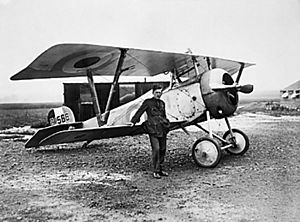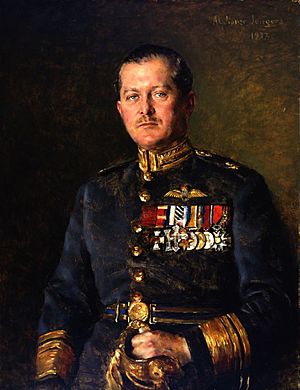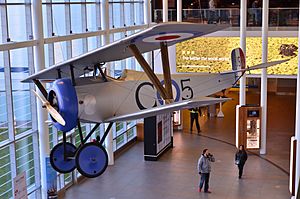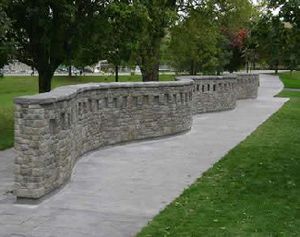Billy Bishop facts for kids
Quick facts for kids
William Bishop
|
|
|---|---|
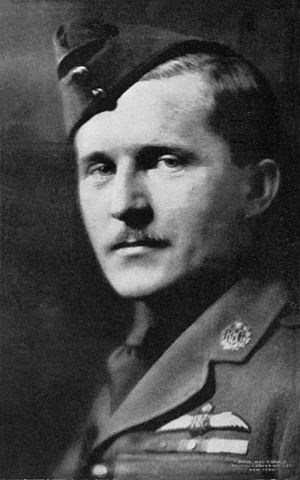
Lieutenant Billy Bishop c.1918
|
|
| Nickname(s) | "Billy" "Bish" |
| Born | 8 February 1894 Owen Sound, Ontario, Canada |
| Died | 11 September 1956 (aged 62) West Palm Beach, Florida, United States |
| Allegiance | Canada United Kingdom |
| Service/ |
Canadian Militia
|
| Years of service | 1914–1918 1936–1944 |
| Rank | Air Marshal |
| Commands held | No. 60 Squadron RAF No. 85 Squadron RAF |
| Battles/wars | First World War Second World War |
| Awards | Victoria Cross Companion of the Order of the Bath Distinguished Service Order & Bar Military Cross Distinguished Flying Cross Mentioned in Despatches Canadian Efficiency Decoration Chevalier of the Legion of Honour (France) Croix de guerre (France) |
| Alma mater | Royal Military College of Canada |
William Avery Bishop was a brave Canadian flying ace during the First World War. He was known as "Billy" and became the top Canadian and British Empire ace, meaning he shot down more enemy planes than anyone else from those countries. He was officially credited with 72 victories. For his amazing courage, he received the Victoria Cross, the highest military award. Later, in the Second World War, Billy Bishop helped create and promote the British Commonwealth Air Training Plan, which trained many pilots in Canada.
Contents
Discovering Billy Bishop's Early Life
William Avery Bishop was born in Owen Sound, Ontario, Canada, on February 8, 1894. He was the third of four children. His father, William Avery Bishop Sr., was a lawyer. Billy was very close to his younger sister, Louise.
School Days and Early Adventures
Growing up in Owen Sound, Billy was a bit different from other kids. He had a slight lisp and went to dancing school with girls. He also wore suits to school, which his classmates didn't like. Billy wasn't a fan of team sports. Instead, he preferred activities like riding horses, swimming, or playing billiards.
He became a very good shot with a rifle. His dad gave him a .22 caliber rifle for Christmas. Billy earned money by shooting squirrels that were causing trouble in the family orchard. He learned how to hit moving targets, which was a skill that would help him later in life.
Billy was also known for standing up to bullies. He once fought seven boys and won! Even though he was slender, he was handsome and popular with girls. However, he didn't do very well in school, often skipping classes or giving up on subjects he found hard.
When he was 16, Billy tried to fly a glider he built from cardboard and bedsheets off his three-story house. It crashed, but he wasn't hurt. His sister Louise helped him hide the mess. She then made him go on a date with her friend, Margaret Burden. Margaret was the granddaughter of Timothy Eaton, who owned a big department store. Billy and Margaret quickly fell in love.
College Challenges and War Calls
In 1911, Billy Bishop joined the Royal Military College of Canada (RMC) in Kingston, Ontario. He struggled a lot during his first year, both with his studies and with older students teasing him. He even got caught cheating on an exam but managed to avoid being kicked out.
He continued to struggle with his grades. But when the First World War began in 1914, many of his classmates left to become officers. Billy decided to leave RMC too. On September 30, 1914, he joined a cavalry unit called the Mississauga Horse. Before reporting for duty, he went to Toronto to tell Margaret Burden his decision.
Billy Bishop's First World War Journey
Billy Bishop's journey into the war started with some bad luck. He got sick with pneumonia and allergies, so he couldn't go with his unit to the war. After he got better, he joined another unit, the 7th Canadian Mounted Rifles, in January 1915. He was in charge of the machine guns and was popular with the soldiers, who called him "Bish" or "Billy."
From Mud to the Air
More accidents followed. A horse fell on him, and a rifle part hit his cheek. He also got very sick from a shot. During this time, he secretly went to Margaret and proposed marriage. She said yes, and they became engaged.
In June 1915, Billy's unit sailed to England on a ship that used to carry cattle. The journey was rough, with bad food and many sick men and horses. German U-boats attacked their group of ships, sinking three, but Billy's ship made it safely to England.
Training in England was tough, with lots of mud and horse manure. One day, Billy saw an airplane land nearby. He thought, "You don't get any mud or horseshit on you up there. If you died, it would be a clean death." This made him want to join the air force.
Learning to Fly and Observe
Billy managed to get an appointment with the Royal Flying Corps (RFC). Since becoming a pilot would take a year, he decided to become an aerial observer first. This meant he would fly in a plane and help direct artillery fire. He started training in September 1915.
His first missions were over the English Channel, helping to guide bombs. On November 24, his pilot crashed their plane, but both were only bruised. Billy often exaggerated his adventures in letters to Margaret, like claiming a dive at 300 mph in a plane that couldn't go half that fast!
In January 1916, Billy's squadron moved to France. At this time, German planes called Fokker Eindeckers were very dangerous because they could shoot through their propellers. The RFC started flying in groups for safety. Billy noticed that German and British pilots were often polite to each other, even exchanging messages about casualties.
Billy's time as an observer was full of small injuries. He got frostbite, was in a car crash, hit his head on a cable, and hurt his knee. After one injury, he ended up in a hospital in England. There, a kind and influential woman named Lady St. Helier helped him. She invited him to stay at her mansion, where he met many important people.
Because of his injuries, Billy was sent back to Canada to recover. He was seen as a hero in his hometown. While there, Margaret's parents finally agreed to their engagement, and she received a real engagement ring.
Becoming a Fighter Pilot
In September 1916, Billy returned to England. With Lady St. Helier's help, he was accepted for pilot training. He learned to fly different types of planes. After getting his pilot's wings, he joined No. 37 Squadron RFC but didn't like flying at night. He soon asked to be sent to France.
On March 17, 1917, Billy joined 60 Squadron in France, flying the Nieuport 17 fighter plane. At this time, new pilots didn't last long, and German pilots were very skilled. Billy's first patrol was difficult; he almost got shot down and lost his group. After a crash landing during practice, he was almost sent back to flight school.
But the very next day, March 25, Billy got his first victory! He was part of a group of four planes that fought three German planes. Billy shot down one, but his engine failed, and he had to land in no man's land, close to the German front line. He ran to the Allied trenches and spent the night there in the rain. This exciting adventure made the general change his mind, allowing Billy to stay.
Rising to Ace Status
Just a few days later, Billy was promoted to captain. He started flying many solo missions deep into enemy territory, with his commander's permission. He quickly shot down more and more enemy planes. On April 8, he got his fifth victory, making him an "ace." To celebrate, his mechanic painted the nose of his plane blue.
Billy's aggressive flying style meant he was always leading the charge. He realized this was risky after one flight where his plane had 210 bullet holes! He changed his tactics to focus on surprise attacks, which worked well. He shot down 12 planes in April alone and earned the Military Cross. The Germans noticed him too, calling him "Hell's Handmaiden" and even putting a reward on his head.
On June 2, 1917, Billy flew a solo mission to attack a German airfield. He claimed to have shot down three planes taking off and destroyed several more on the ground. For this incredible feat, he was awarded the Victoria Cross (VC). While some historians have questioned if there were witnesses, it was common for Billy's claims to be accepted without extra proof.
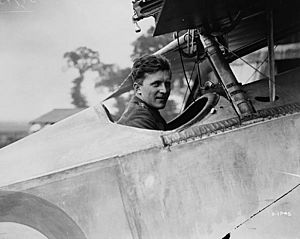
In July, 60 Squadron got new, faster planes. By August 1917, Billy had surpassed another famous ace, Albert Ball, to become the highest-scoring ace in the RFC. He was the third top ace of the war overall. At the end of August, he was promoted to major and became the chief instructor at the School of Aerial Gunnery.
A Hero's Welcome and Return to War
Billy returned to Canada for a break in the fall of 1917. He was a national hero, and his return helped boost everyone's spirits during the war. On October 17, 1917, he married his longtime fiancée, Margaret Eaton Burden. After their wedding, he went to Washington, D.C., to help the Americans build their air force. While there, he wrote a book about his experiences called Winged Warfare.
When he came back to England in April 1918, Billy was promoted to major again and given command of a new squadron, No. 85 Squadron, known as the "Flying Foxes." He chose many of the pilots himself. On May 27, he flew his first combat mission since August 1917 and shot down a German observation plane. He quickly added more victories.
From May 30 to June 1, Billy shot down six more planes, bringing his total to 59. He was once again the leading Allied ace. The Canadian government became worried that if Billy were killed, it would hurt public morale. So, on June 18, he was ordered to return to England to help organize the new Canadian Flying Corps.
Billy wasn't happy about leaving France so soon. On the morning of June 19, before his deadline, he decided to fly one last solo patrol. In just 15 minutes, he claimed five more victories, bringing his total to 72. He said he shot down two planes, caused two others to crash into each other, and destroyed a reconnaissance aircraft.
On August 5, Billy was promoted to lieutenant-colonel. He was on a ship returning from Canada when news of the war ending arrived. He left the military on December 31 and went back to Canada. While he was officially credited with 72 victories, some historians believe the actual number might have been lower, around 27.
Life After the Wars
After the First World War, Billy Bishop traveled around the United States, giving talks about air combat. He tried starting a business importing aircraft and even a passenger airline with another ace, William Barker. But they faced problems, and the businesses didn't last.
In 1921, Billy and his family moved to Britain, where he worked in aviation-related businesses. In 1928, he was honored by German air aces in Berlin. He became chairman of British Air Lines in 1929. However, his family lost most of their money in the stock market crash of 1929, and they had to move back to Canada. There, he became a vice-president at an oil company.
Serving in the Second World War
In January 1936, Billy Bishop became the first Canadian air vice-marshal. When the Second World War began in 1939, he was promoted to air marshal in the Royal Canadian Air Force (RCAF). In 1940, he became the Director of Recruiting for the RCAF. He was so good at this job that many people wanted to join, and some even had to be turned away.
Billy was key in creating a system to train pilots across Canada. He helped set up and promote the British Commonwealth Air Training Plan, which trained over 167,000 airmen in Canada during the war. In 1942, he even appeared as himself in a Hollywood movie called Captains of the Clouds, which honored the RCAF.
By 1944, the stress of the war had affected Billy's health. He left his job in the RCAF and returned to private business in Montreal, Quebec. He retired in 1952. His son later said that Billy looked 70 years old on his 50th birthday in 1944. Still, Billy remained active in aviation, predicting that commercial flights would grow hugely after the war. His efforts helped create the International Civil Aviation Organization (ICAO) in Montreal. He also wrote another book, Winged Peace, where he suggested that global air power should be controlled internationally.
When the Korean War started, Billy offered to help with recruiting again. But his health was poor, and the RCAF politely declined. He passed away peacefully in his sleep on September 11, 1956, at age 62, while in Palm Beach, Florida. His funeral was held in Toronto with full Air Force honors. His ashes were buried in his family's plot in Greenwood Cemetery in Owen Sound.
Billy Bishop's Family Life
On October 17, 1917, Billy Bishop married Margaret Eaton Burden in Toronto. She was the granddaughter of Timothy Eaton, a famous department store owner. They had a son, William, and a daughter, Margaret.
Both of Billy's children followed in his footsteps and became aviators:
- William Arthur Christian Avery Bishop (1923–2013) was given his pilot's wings by his father during the Second World War. He flew Spitfire planes. After the war, he became a journalist and author.
- Margaret Marise (Jackie) Willis-O’Connor (1926–2013) was a wireless radio operator during World War II. Her father presented her with her Wireless Sparks Badge in 1944.
Honors and Tributes to Billy Bishop
Billy Bishop received many honors for his bravery and service. In 1967, he was inducted into the International Air & Space Hall of Fame. The Air Force Association of Canada also created a trophy in his name to recognize outstanding achievements in Canadian aviation.
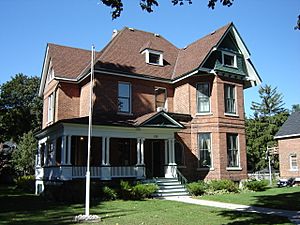
Billy Bishop's childhood home in Owen Sound, Ontario, became the Billy Bishop Home and Museum in 1987. The museum has exhibits about his family, his life, and other veterans. There's also a permanent exhibit about him at the Grey Roots Museum and Archives near Owen Sound.
Billy Bishop's life has also been featured in plays, films, and documentaries. Billy Bishop Goes to War is a well-known Canadian musical and film. A documentary called A Hero to Me: The Billy Bishop Story was made in 2003, telling his story from his granddaughter Diana's point of view.
He has even been on Canadian stamps! On August 12, 1994, Canada Post released a stamp called "Billy Bishop, Air Ace" as part of their Great Canadians series.
Several places are named after Billy Bishop:
- Two airports in Ontario bear his name: the Owen Sound Billy Bishop Regional Airport and the Billy Bishop Toronto City Airport in Toronto.
- "Billy Bishop Private" is a road at Ottawa Airport, which also has a "Billy Bishop Room" for important visitors.
- "Billy Bishop Way" is a street near the Downsview Airport in Toronto.
- "Billy Bishop Park" is a public park in Ottawa.
- Mount Bishop, a 2,850-meter-high mountain on the Alberta–British Columbia border.
- The "Bishop Building" is the headquarters for the 1st Canadian Air Division in Winnipeg, Manitoba.
- The "Billy Bishop Legion Branch 176" is in Vancouver, British Columbia.
- The "CFB Borden Billy Bishop Centre" is a training school at CFB Borden in Ontario.
- The "Billy Bishop entrance" is at Memorial School in Hamilton, Ontario.
- The "Billy Bishop Hangar" is at the Brampton, Ontario Flying Club.
In 2009, Billy Bishop's name was added to the Wall of Honour at the Royal Military College of Canada in Kingston, Ontario. The Air Force Association of Canada also gives out the Air Marshal W. A. Bishop Memorial Trophy, one of Canada's top awards for aviation. There is also the Sqn 167 Air Marshal Bishop Squadron of the Royal Canadian Air Cadets in Owen Sound.
His former home in Ottawa, built in 1905, is sometimes open to the public during the annual Doors Open Ottawa event.
Images for kids
See also
 In Spanish: Billy Bishop para niños
In Spanish: Billy Bishop para niños


